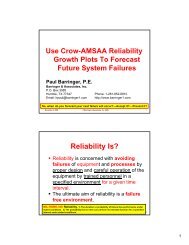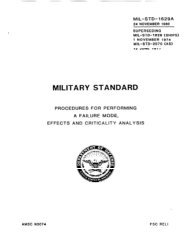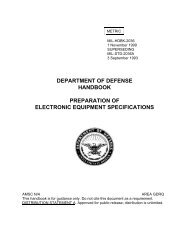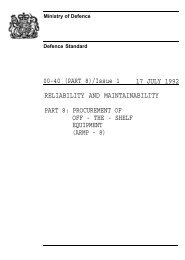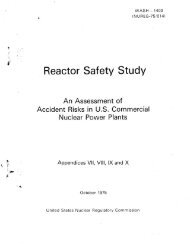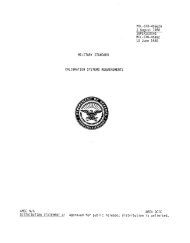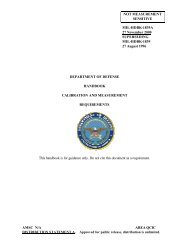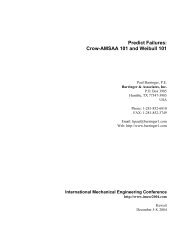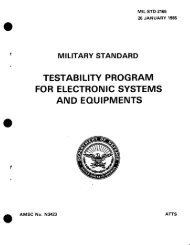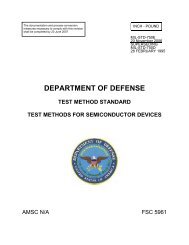Weibull Analysis Of Failures - Barringer and Associates, Inc.
Weibull Analysis Of Failures - Barringer and Associates, Inc.
Weibull Analysis Of Failures - Barringer and Associates, Inc.
You also want an ePaper? Increase the reach of your titles
YUMPU automatically turns print PDFs into web optimized ePapers that Google loves.
<strong>Weibull</strong> <strong>Analysis</strong>It’s Not About Complicated Statistics.<strong>Weibull</strong> <strong>Analysis</strong> Tells The “Medicine”You Need For Solving Your Problems.Paul <strong>Barringer</strong>, P.E.<strong>Barringer</strong> & <strong>Associates</strong>, <strong>Inc</strong>.P.O. Box 3985Humble, TX 77347 Phone: 1-281-852-6810Email: hpaul@barringer1.com http://www.barringer1.comFor More Reliability Tools: See http://www.barringer1.com/nov07prb.htmApril 9, 2009© <strong>Barringer</strong> & <strong>Associates</strong>, <strong>Inc</strong>. 2009 1
Wallodi <strong>Weibull</strong>English Pronunciation: Wah-Low-D Y-Bull• Wallodi <strong>Weibull</strong> (1887-1979) invented thelife data analysis technique. He livedmost of his life in Sweden working onproblems with materials, fatigue, strength,rupture, <strong>and</strong> bearing fatigue life.• His statistics are based on a concept offailure of the weakest link in a chain.• His most famous <strong>Weibull</strong> engineeringpaper was published by ASME in 1951.© <strong>Barringer</strong> & <strong>Associates</strong>, <strong>Inc</strong>. 2009 2
<strong>Weibull</strong> Plots For Components• Collect age-to-failure data for eachcomponent. This is tombstone data: timeat death less time at birth = age-to-failure.• Each age-to-failure data for components isplotted in rank order as the X-value.• The Y-value is determined by Benard’smedian rank calculation to reduce bias inthe plot.© <strong>Barringer</strong> & <strong>Associates</strong>, <strong>Inc</strong>. 2009 3
What Does The Data Say?• We have 3 similar units operating for less than ayear. We’ve had 5 failures. The ages-to-failure(hours of operating time) are: 1200, 2200, 3000,4500, 5100 as shown in rank order. (X-axis data)• The Y-axis plot position in Benard’s rank order is:12.96%, 31.48%, 50%, 68.52%, 87.04%.• What’s the failure mode? What’s thecharacteristic life (typical life) of thecomponent?© <strong>Barringer</strong> & <strong>Associates</strong>, <strong>Inc</strong>. 2009 4
The Bathtub Curve TellsAbout Human Failure RatesAverage Age At Death: 20 th Century 77 yrs, 17 th Century 32 yrs--Why?Late 20 th CenturyHuman Mortality RatesInfantChanceOld AgeBathtubCombinedRatesYou see bathtubcurves for humans.Why don’t you seebathtub curvesfor equipment?Beyond the age of 10 years,infant mortality is not abig problem ------------------>0 20 40 60 80 100Age
Failure Statistics<strong>Weibull</strong> DistributionsProbability distribution function, f(t)PDFCurvef infant ( t )f chance ( t )f wearout ( t )f( t ) . t ( ) . 1 et0.0020.001Infant = 0.5Wearout = 5Chance = 100 1000 2000tInstantaneous failure rate, h(t)Hazard 0.002Curveh( t ) .h infant ( t )h chance ( t )h wearout( t )t 10.0010Wearout, > 10 1000 2000tChance, =1Infant < 1 = 1000
What Does The Plot Tell Us?63.2%This is a double logarithmic scaleX(hours)Y%1200 12.962200 31.483000 50.004500 68.525100 87.04pve% is a goodness ofcurve fit criteria <strong>and</strong> needsto be 10% or greater• For components: < 1 = infant mortality ≈ 1 = chance failures > 1 = wear out failures• For components = characteristic life asthis distribution has along tail to the rightUnreliability = 1.789= line slope = 3724n = number ofdatapointss = number ofsuspended data = 3724Long tail to the rightThis is a logarithmic scaleThe red trendline tells what percent of the population will die by a give time. Relative Frequency <strong>Of</strong> Occurrence© <strong>Barringer</strong> & <strong>Associates</strong>, <strong>Inc</strong>. 2009 Linear Age Scale 7
Why <strong>Weibull</strong>’s• They tell HOW things die—i.e. you get technicalsupport for failure modes• They give objective evidence for FMEA’s toguide RCM decisions with facts—not opinions• They use data from your CMMS (or fromstores, or from purchasing, or frommaintenance work orders, etc.)• They make sense from the apparent nonsenseof failure details to answer businessquestions for maintenance <strong>and</strong> engineering© <strong>Barringer</strong> & <strong>Associates</strong>, <strong>Inc</strong>. 2009 8
Conditional Reliability• Suppose I have a similar component 81.6%that is still alive at 4,000 hours.67.9%From the graph the probability offailure is 67.9% or reliability is 32.1%.• What probability do I have for thecomponent surviving for a life of5,000 hours? From the graph theprobability of failure is 81.6% orreliability is 18.38%.• Condition reliability for living another 1000 hrs =R(5000hrs)/R(4000 hrs) = 18.38%/32.1% = 57.25%• Probability of survival = 57.25%Probability of failure = 42.75%,Unreliability© <strong>Barringer</strong> & <strong>Associates</strong>, <strong>Inc</strong>. 2009 95%10%20%30%40%50%60%70%80%90% Your odds for living another1000 hours are better than youhad for getting from 0 hoursto 4000 hours.Reliability
Use <strong>Weibull</strong>s To DoUse previous<strong>Weibull</strong> dataTimed Replacements?• Cost for a plannedreplacement = $5,000• Cost of an unplannedreplacement = $20,000• Run to failure? Do atimed replacement?—If so, when?• <strong>Weibull</strong>’s <strong>and</strong> $’s savearguments <strong>and</strong> time!!• When in doubt—useyour brains + technologyHigh Cost <strong>Of</strong>PMs Too EarlyCost $/hr= 1.789, = 3724 hrs,C p = $5,000, C up = $20,000Optimum replacement@ 2,400 hrs where cost is$5.13/hr. Run to failurecost is $5.45/hr.OptimumReplacement =5.13/hrEquipment Age (hours)High Cost <strong>Of</strong>PMs Too LateRunTowardFailure =$5.45/hr= $0.32/hrWorthOptimumReplacement?© <strong>Barringer</strong> & <strong>Associates</strong>, <strong>Inc</strong>. 2009 10
Use <strong>Weibull</strong>s To PredictHow Many Replacements?Use previous<strong>Weibull</strong> data• We have the followingparts in service: 1@30005@2000, 6 @1500,10@1000hrs. When theyfail we’ll replace with = 10,000 hrs upgrades.• How many parts will weneed in the next 5 years?71 replacementsrequired in next5 years. Newparts have = 1.789<strong>and</strong> = 10,000 hoursOld parts with 3724 hour lifehave been used up. New <strong>and</strong>more durable replacements© <strong>Barringer</strong> & <strong>Associates</strong>, <strong>Inc</strong>. 2009 are being installed <strong>and</strong> usedwith 10,000 hour life.11
<strong>Weibull</strong> <strong>Analysis</strong> <strong>Of</strong> <strong>Failures</strong>• <strong>Weibull</strong> analysis of failure data tellshow the component died (infant, chanceor wear-out). The failure mode suggestsspecific corrective action.• One set of math h<strong>and</strong>les tailed data.• Use age-to-failure data (<strong>and</strong> useproduction data for process <strong>Weibull</strong>s).• About 85-95% of all life data makes astraight line on a <strong>Weibull</strong> plot. When indoubt, use the <strong>Weibull</strong> plots for life data.WhatWhyWhenWhere© <strong>Barringer</strong> & <strong>Associates</strong>, <strong>Inc</strong>. 2009 12
Sharpen Your TechnicalSkills With <strong>Weibull</strong> <strong>Analysis</strong>• Use your CMMS failure data to be fact driven withfailure modes determined by technical <strong>Weibull</strong> analysis• Use <strong>Weibull</strong> analysis to forecast future failures• Use <strong>Weibull</strong> analysis for timed replacement decisionsbased on financial decisions• Use <strong>Weibull</strong> analysis to support your RCM technicaldecisions by providing persuasive arguments <strong>and</strong> crispdecisions for money saving actions• Which are you using? <strong>Weibull</strong> technical facts aboutfailure modes? Or seat of pants opinion for engineering<strong>and</strong> maintenance conclusions.© <strong>Barringer</strong> & <strong>Associates</strong>, <strong>Inc</strong>. 2009 13
Reading Resources• <strong>Weibull</strong>’s Biography:http://www.barringer1.com/weibull_bio.htm• <strong>Weibull</strong>’s Collection <strong>Of</strong> Technical Papershttp://www.barringer1.com/wa.htm• The New <strong>Weibull</strong> H<strong>and</strong>book, 5 th edition US$98http://www.barringer1.com/tnwhb.htm• International <strong>Weibull</strong> St<strong>and</strong>ard IEC-61649-2008http://www.iec.ch• Worked Out <strong>Weibull</strong> Exampleshttp://www.barringer1.com/problem.htmFreeDownloadFreeDownload~US$250FreeDownload© <strong>Barringer</strong> & <strong>Associates</strong>, <strong>Inc</strong>. 2009 14



